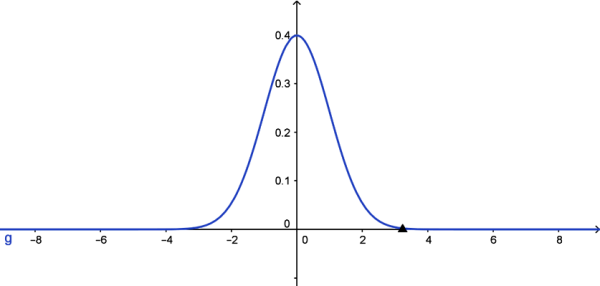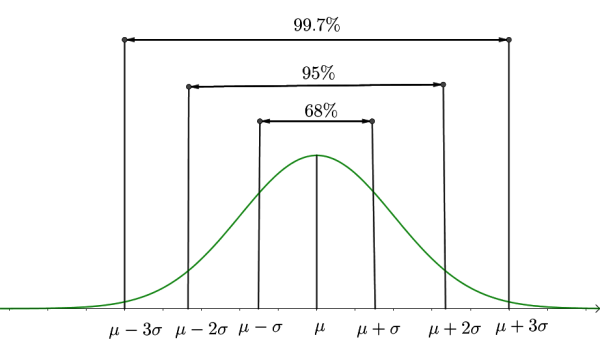Empirical Rule Calculator
Empirical Rule Calculator measures the share of values that fall within a specified number of standard deviations from the mean. It's an online statistics and probability tool requires data set $X$ and determines the percentage of values around the mean for the standard deviation width of $\sigma$, $2\sigma$ and $3\sigma$
It is necessary to follow the next steps:
- Enter a data set $X$ (observed values) in the box. These values must be real numbers or variables and may be separated by commas. The values can be copied from a text document or a spreadsheet.
- Press the "CALCULATE" button to make the computation.
- Empirical rule calculator determines if a given data set follows a normal distribution by checking if $68\%$ of data falls within $\sigma$, $2\sigma$ and $3\sigma$, respectively.
Output: Intervals of real numbers $(\mu-\sigma, \mu+\sigma)$, $(\mu-2\sigma, \mu+2\sigma)$, $(\mu-3\sigma, \mu+3\sigma)$ or $(\bar{X}-s_X, \bar{X}+s_X)$, $(\bar{X}-2s_X, \bar{X}+2s_X)$, $(\bar{X}-3s_X, \bar{X}+3s_X)$
Empirical rule calculator gives us the stepwise procedure and insight into every step of calculation. Before the final result of empirical rule is derived, it calculates the mean and standard deviation. These values can be of benefit for further solving of problems and applications.
Empirical Rule Population Formula: If the data set is a population then,
- Empirical Rule at 68\% falls between $\mu-\sigma$ and $\mu+\sigma$
- Empirical Rule at 95\% falls between $\mu-2\sigma$ and $\mu+2\sigma$
- Empirical Rule at $99.7\%$ falls between $\mu-3\sigma$ and $\mu+3\sigma$
where the population mean is $\mu=\frac {1}{N}\sum_{i=1}^Nx_i$ and
population standard deviation is $\sigma=\sqrt{\frac{\sum_{i=1}^N(x_i-\mu)^2}{N}}$
- Empirical Rule at 68\% falls between $\bar{X}-s_X$ and $\bar{X}-s_X$
- Empirical Rule at 95\% falls between $\bar{X}-2s_X$ and $\bar{X}+2s_X$
- Empirical Rule at $99.7\%$ falls between $\bar{X}-3s_X$ and $\bar{X}+3s_X$
where the sample mean is $\bar X=\frac {1}{n}\sum_{i=1}^nx_i$ and
sample standard deviation is $s_X=\sqrt{\frac{\sum_{i=1}^n(x_i-\mu)^2}{n-1}}$
What is Empirical Rule?
We can measure the percentage of data that is a certain distance from the mean no matter what the standard deviation of the set is. If the mean is $\mu=0$ and the standard deviation is $\sigma=1$ the curve is called a standard normal distribution. In this case, the values of $x$ represent the number of standard deviations distanced from the mean.

The Bell shaped curve, Bell curve or Gaussian function is used to represent the distribution of probability density function. The mean determines the location of the center of the Bell curve, and the standard deviation determines the height and width of the Bell curve. Note that the total area under the curve is 1. The term $68-95-99.7$ in normal distribution represents $68.27\%$, $95.45\%$ and $99.73\%$ of data around the mean for the width of $\sigma$, $2\sigma$ and $3\sigma$, respectively. In other words, for a normally distributed random variable $X$ with the population mean $\mu$ and the population standard deviation $\sigma$, it holds that $$\begin{align} &P(\mu-\sigma < X < \mu+\sigma)\approx 0.68\\ &P(\mu-2\sigma < X < \mu+2\sigma)\approx0.95\\ &P(\mu-3\sigma < X < \mu+3\sigma)\approx 0.997\end{align}$$

- About 68% of the data lie within one standard deviation of the mean;
- About 95% of the data lie within two standard deviations of the mean;
- About 99.7% of the data lie within three standard deviations of the mean
How to Calculate Empirical Rule?
To find the empirical rule we need to follow next steps
- Find the number of the given data set, $n$;
- Find the population or sample mean of the set as the sum of the values divided by $n$;
- Find the population or sample standard deviation.
- Empirical Rule at $68\%$ falls between $\mu-\sigma$ and $\mu+\sigma$
- Empirical Rule at $95\%$ falls between $\mu-2\sigma$ and $\mu+2\sigma$
- Empirical Rule at $99.7\%$ falls between $\mu-3\sigma$ and $\mu+3\sigma$
where the population mean is $\mu=\frac {1}{N}\sum_{i=1}^Nx_i$ and
population standard deviation is $\sigma=\sqrt{\frac{\sum_{i=1}^N(x_i-\mu)^2}{N}}$
- Empirical Rule at 68\% falls between $\bar{X}-s_X$ and $\bar{X}-s_X$
- Empirical Rule at 95\% falls between $\bar{X}-2s_X$ and $\bar{X}+2s_X$
- Empirical Rule at $99.7\%$ falls between $\bar{X}-3s_X$ and $\bar{X}+3s_X$
where the sample mean is $\bar X=\frac {1}{n}\sum_{i=1}^nx_i$ and
sample standard deviation is $s_X=\sqrt{\frac{\sum_{i=1}^n(x_i-\mu)^2}{n-1}}$
Practice Problems for Empirical Rule
In statistical data analysis, when working along with standard deviation calculation, there may be many occasions that the user may need to find the percentage of data fall around the mean. Applications of the empirical rule are to determine if some data set follows a normal distribution and also to determine what the probability is of certain data occurring. The Empirical Rule is very important in statistics for forecasting, i.e. when obtaining the data is difficult or impossible to find. The Empirical Rule has application in hypothesis testing, process control, creating work standards, and in menu real-life situations. For instance, in hypothesis testing, the empirical rule finds confidence intervals. These intervals are used in testing to check if outcomes from a change are the result of the normal process or are different from the starting behavior.
Practice Problem 1 :
The heights of students in a class have a normal distribution with a mean of $180$ centimeters and a standard deviation of $5$ centimeters.
Find the interval that contains about $95\%$ of the students.
Practice Problem 2 :
The weights of cats have a normal distribution with a mean of $3.6$ pounds and a standard deviation of $0.4$ pounds.
What percent of cats weigh between $2.8$ and $4.8$ kilograms?
Practice Problem 3 :
The special type of dogs lives $3.1$ years and the standard deviation is $0.60$ years. Find the probability of a dog living less than $2.52$ years, if the lifespans of these dogs are normally distributed.
The empirical rule Calculator, formula, and practice problems would be very useful for grade school students (K-12 education) primarily in statistical and probability problems. Because many natural phenomena have approximately the normal distribution, some real-life situations can be solved by using this concept.
